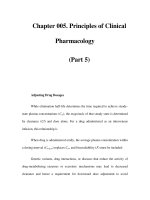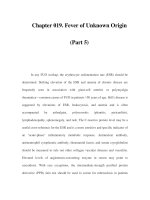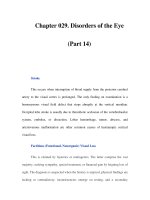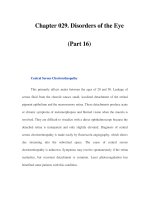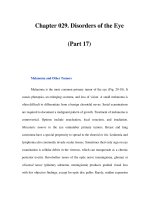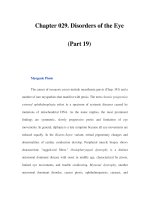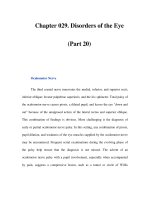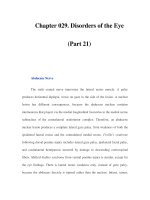Chapter 029. Disorders of the Eye (Part 5) pps
Bạn đang xem bản rút gọn của tài liệu. Xem và tải ngay bản đầy đủ của tài liệu tại đây (12.32 KB, 5 trang )
Chapter 029. Disorders of the Eye
(Part 5)
Ventral view of the brain, correlating patterns of visual field loss with
the sites of lesions in the visual pathway.
The visual fields overlap partially, creating 120° of central binocular field
flanked by a 40° monocular crescent on either side. The visual field maps in this
figure were done with a computer-driven perimeter (Humphrey Instruments, Carl
Zeiss, Inc.). It plots the retinal sensitivity to light in the central 30° using a gray
scale format. Areas of visual field loss are shown in black. The examples of
common monocular, prechiasmal field defects are all shown for the right eye. By
convention, the visual fields are always recorded with the left eye's field on the
left, and the right eye's field on the right, just as the patient sees the world.
The crux of visual field analysis is to decide whether a lesion is before, at,
or behind the optic chiasm. If a scotoma is confined to one eye, it must be due to a
lesion anterior to the chiasm, involving either the optic nerve or retina. Retinal
lesions produce scotomas that correspond optically to their location in the fundus.
For example, a superior-nasal retinal detachment results in an inferior-temporal
field cut. Damage to the macula causes a central scotoma (Fig. 29-3B).
Optic nerve disease produces characteristic patterns of visual field loss.
Glaucoma selectively destroys axons that enter the superotemporal or
inferotemporal poles of the optic disc, resulting in arcuate scotomas shaped like a
Turkish scimitar, which emanate from the blind spot and curve around fixation to
end flat against the horizontal meridian (Fig. 29-3C). This type of field defect
mirrors the arrangement of the nerve fiber layer in the temporal retina. Arcuate or
nerve fiber layer scotomas also occur from optic neuritis, ischemic optic
neuropathy, optic disc drusen, and branch retinal artery or vein occlusion.
Damage to the entire upper or lower pole of the optic disc causes an
altitudinal field cut that follows the horizontal meridian (Fig. 29-3D). This pattern
of visual field loss is typical of ischemic optic neuropathy but also occurs from
retinal vascular occlusion, advanced glaucoma, and optic neuritis.
About half the fibers in the optic nerve originate from ganglion cells
serving the macula. Damage to papillomacular fibers causes a cecocentral scotoma
encompassing the blind spot and macula (Fig. 29-3E). If the damage is
irreversible, pallor eventually appears in the temporal portion of the optic disc.
Temporal pallor from a cecocentral scotoma may develop in optic neuritis,
nutritional optic neuropathy, toxic optic neuropathy, Leber's hereditary optic
neuropathy, and compressive optic neuropathy. It is worth mentioning that the
temporal side of the optic disc is slightly more pale than the nasal side in most
normal individuals. Therefore, it can sometimes be difficult to decide whether the
temporal pallor visible on fundus examination represents a pathologic change.
Pallor of the nasal rim of the optic disc is a less equivocal sign of optic atrophy.
At the optic chiasm, fibers from nasal ganglion cells decussate into the
contralateral optic tract. Crossed fibers are damaged more by compression than
uncrossed fibers. As a result, mass lesions of the sellar region cause a temporal
hemianopia in each eye. Tumors anterior to the optic chiasm, such as
meningiomas of the tuberculum sella, produce a junctional scotoma characterized
by an optic neuropathy in one eye and a superior-temporal field cut in the other
eye (Fig. 29-3G). More symmetric compression of the optic chiasm by a pituitary
adenoma (Fig. 333-4), meningioma, craniopharyngioma, glioma, or aneurysm
results in a bitemporal hemianopia (Fig. 29-3H). The insidious development of a
bitemporal hemianopia often goes unnoticed by the patient and will escape
detection by the physician unless each eye is tested separately.
It is difficult to localize a postchiasmal lesion accurately, because injury
anywhere in the optic tract, lateral geniculate body, optic radiations, or visual
cortex can produce a homonymous hemianopia, i.e., a temporal hemifield defect in
the contralateral eye and a matching nasal hemifield defect in the ipsilateral eye
(Fig. 29-3I).
A unilateral postchiasmal lesion leaves the visual acuity in each eye
unaffected, although the patient may read the letters on only the left or right half of
the eye chart. Lesions of the optic radiations tend to cause poorly matched or
incongruous field defects in each eye.
Damage to the optic radiations in the temporal lobe (Meyer's loop)
produces a superior quadrantic homonymous hemianopia (Fig. 29-3J), whereas
injury to the optic radiations in the parietal lobe results in an inferior quadrantic
homonymous hemianopia (Fig. 29-3K).
Lesions of the primary visual cortex give rise to dense, congruous
hemianopic field defects. Occlusion of the posterior cerebral artery supplying the
occipital lobe is a frequent cause of total homonymous hemianopia.
Some patients with hemianopia after occipital stroke have macular sparing,
because the macular representation at the tip of the occipital lobe is supplied by
collaterals from the middle cerebral artery (Fig. 29-3L). Destruction of both
occipital lobes produces cortical blindness. This condition can be distinguished
from bilateral prechiasmal visual loss by noting that the pupil responses and optic
fundi remain normal.
